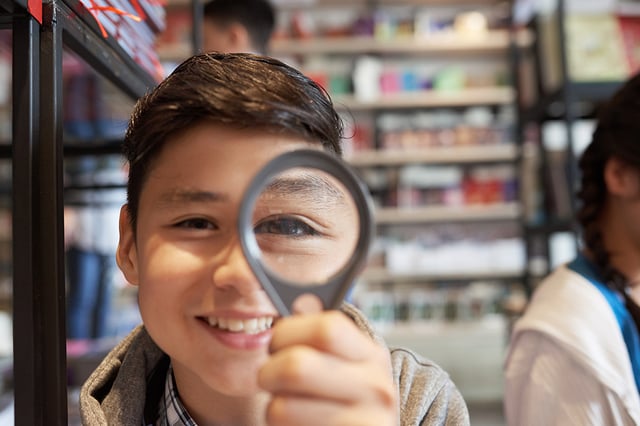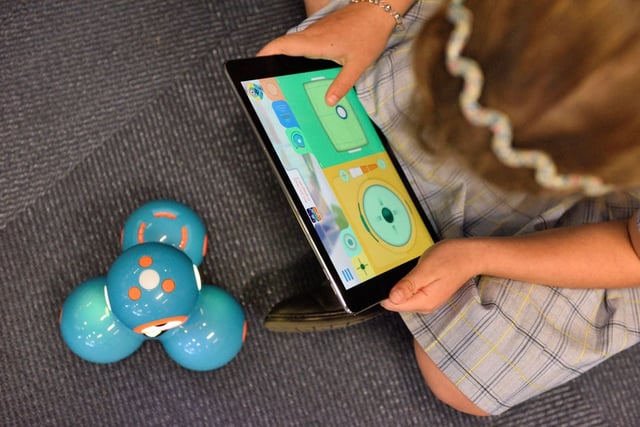Sparking Student Creativity in a Computer Science Makerspace
 Insights By Faith Plunkett
Insights By Faith Plunkett
“One little spark, of inspiration is at the heart, of all creation”
You might recognize this as the jovial tune from Walt Disney’s Journey into Imagination with Figment.
I mean, who doesn’t love Disney?
This sentiment of encouraging imagination through creative, hands-on learning opportunities inspires a lot of Faith Plunkett’s work. That and her love of Disney, of course.
Faith is an Instructional Technology Coach for Decatur City Schools in northern Alabama. She supports teachers across multiple campuses with technology integration in the classroom, emphasizing computer science and maker-based learning. She also travels the country as a member of the ISTE STEM Leadership Team helping teachers to elevate how they teach with technology. When outside school walls, you can find Faith leading Disney Edcamps and participating in #edchats on Twitter.
I had the chance to connect with Faith about her work as a teacher, coach, and technology enthusiast and discuss what inspires her to pursue and advocate for a new approaches to education – one that embraces technology, facilitates student-led learning, and encourages those sparks of inspiration. Here is some of our conversation.
Student Creativity Knows No Bounds
You started your career as a classroom teacher and are now a national digital innovator. What first inspired you to use digital tools and develop maker-based learning experiences?
“I have a fine arts background and have always loved technology because I love being able to create with it. There is a huge connection between the fine arts and technology. You can create music, you can create art, and you can create digital content.
When I first started teaching, I saw that our students were consuming so much, but I wanted them to create because we have such a powerful tool to do this. So many teachers use those devices as a digital worksheet, so giving them the ability to create and explore their passions has been so much fun. And I loved the way this got my students learning.
Early on, I went to an Edcamp, and I saw what a makerspace looked like. That little light bulb went off, and I thought, ‘How many of our kids need something like this thing?’ They have the desire to create and use their imagination, but they're not often given the tools and the resources, or freedom, to be able to do that.
Then, my school got a program called the Entertainment Technology Academy, which is a K-12 computer science and video game design program. I was assigned to teach at the elementary level. This was when computer programming was just coming out, so there weren't a lot of mentors out there. My fellow teachers and I had to be creative with the resources we had and explore ways to give students the ability to do something different and create with computer science.”
Student-Led Learning in Computer Science
As you built a computer science makerspace for the Entertainment Technology Academy, how did you come up with projects for students?
“Most of the things students came up with themselves. I gave them free rein, which I have learned is sometimes a good thing and sometimes not. But the more the kids are exposed to the makerspace, the more structured they are and the more they really start using their imagination.
I would see my kids once a week, but they would work all week on ideas. By the time they came in, they knew what resources they needed, and they would build with them.
Some people think it's a huge mess (which it can be), but there are so many benefits. In education, our kids use their brain so much, but they don't always get the chance to use their imagination. The ability to create is important, and makerspaces and computer science tie right into that.
When they enter the makerspace, they can go in, and they can create anything they want. They can create their own video games. They can program wearables. They can build mazes and have robots go through them. They can create music.”
Building a Growth Mindset for Making, Imagining
Maker-based learning and computer science develop essential attitudes in students like a growth mindset, collaboration, and other entrepreneurial skills. What can this look like in that environment?
“One of the biggest challenges that I had was working with gifted students because they might not understand something right away, but they were used to knowing everything. It was hard for them to persevere sometimes. Sometimes tears were shed, but then they learned how to work through it.
I had a rule that was to ask three before me, so before they came to me with any kind of issue or problem, they had to ask three people. So not only did that help with their growth mindset, but it allowed them to collaborate with their peers. They could team up with people, and it really built a culture of collaboration as well.
I also started talking with my students about that the video games they play – that there is creation behind them. It's not just one person. It’s a team effort. Some people work on the design. Some people work on the actual movie. Some people work on the sounds. Some people work on the marketing. All that ties in together.”
Making Makerspaces Work for Younger Students
For early elementary students, there's this school of thought that they can't do a lot of this work. Is that something you also found? Can you give an example of tailoring projects to work with those younger students?
“A lot of people want to limit kindergarten and first-grade students, but there's so much that they can do. They learn at such a fast rate at that age; they're like little sponges. We just have to make sure that we tailor what we're doing to make it age appropriate.
While their older classmates were programming on a computer, these students were doing more of a hands-on version. With this age group, I did a lot more directed projects in the makerspace with task cards like, ‘build a structure that looks like the Eiffel Tower.' But they still have the ability to use their imagination. We did a lot of activities with sequencing and the Bee-Bot, for example.”
Edcamp Magic, Disney and Imagining
You still attend Edcamps, like the first one that inspired you to create makerspaces. What did a recent makerspace there look like?
“I help organize Edcamp Magic, which is in Orlando and has a Disney theme. Last year was Toy Story theme. We called it Maker Mania. We had little alphabet blocks to create a toy story, a monorail, Legos, and a robot section.
We even had a station called a breaker space with old toys they could reinvent and use to make new things. We had an AR and VR station that was ‘To Infinity and Beyond’. There were also arcade games and coding stations.
We want to expose students to different things so they can find at least one thing they are passionate about whether it’s crafting or coding.”
Future of Education – Creative, Student-Led
To me, there's such a positive thing that comes out of Disney like using creativity and imagination to bring ideas to life. When you imagine a future of education, what does it look like?
“It is a balance between hands-on making and digital making. I watched this video a couple weeks ago about a school that replaced traditional homework with passion-based homework in which students had to research, invent, and create things that interest and inspire them.
Rather than consume and do worksheets, we must shift our focus to having kids create in the classroom, learning through real-world connections, and discovering their passions.
The future of education is giving students the ability to dream and use their imagination.”




